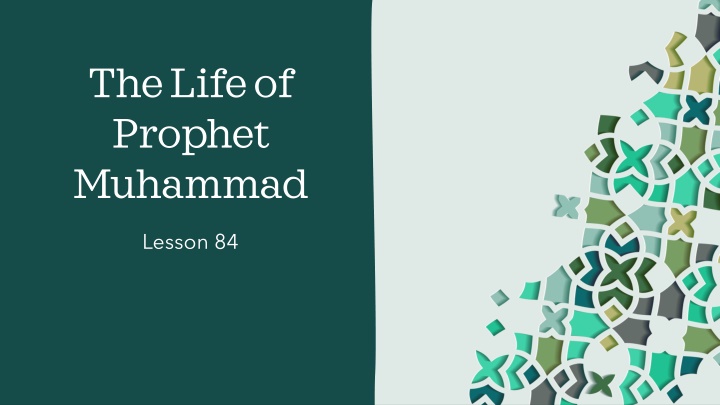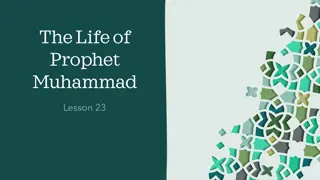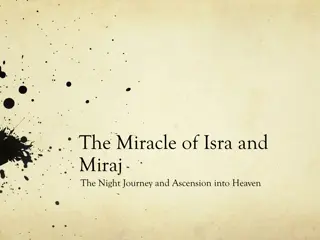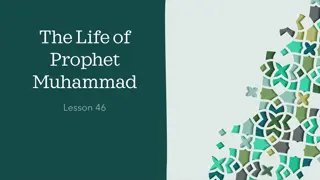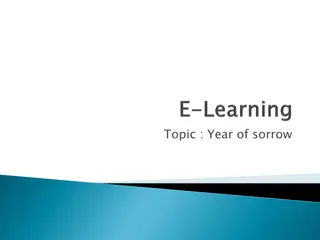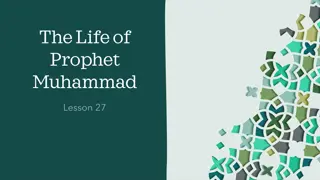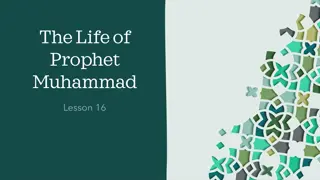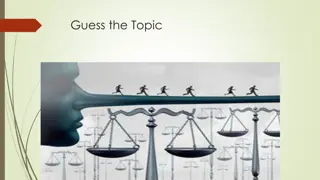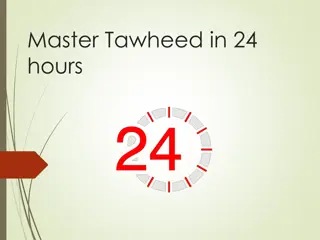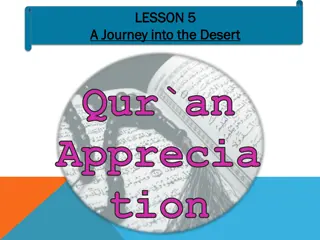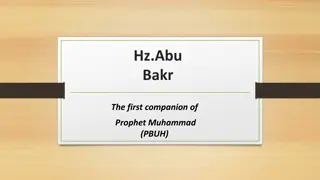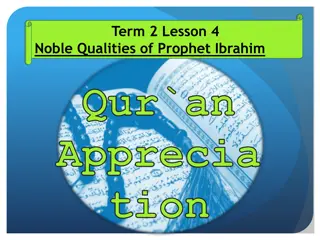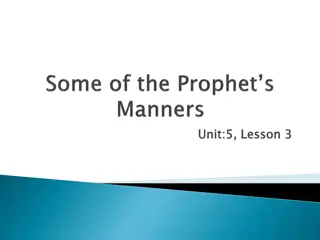The Life of Prophet Muhammad - Lessons and Stories
This engaging content delves into lessons from the life of Prophet Muhammad, including the story of the Hanging Tree and the Battle of Hunayn. Explore important teachings and historical events that offer insights into Islamic faith and wisdom.
Download Presentation

Please find below an Image/Link to download the presentation.
The content on the website is provided AS IS for your information and personal use only. It may not be sold, licensed, or shared on other websites without obtaining consent from the author.If you encounter any issues during the download, it is possible that the publisher has removed the file from their server.
You are allowed to download the files provided on this website for personal or commercial use, subject to the condition that they are used lawfully. All files are the property of their respective owners.
The content on the website is provided AS IS for your information and personal use only. It may not be sold, licensed, or shared on other websites without obtaining consent from the author.
E N D
Presentation Transcript
The Life of Prophet Muhammad Lesson 84
The Story of the Hanging Tree Ibn Ishaq (d. 151 AH) reports from Abu Waqid Al-Laythi: : : .".. ( : ) The disbelievers from Quraysh and the other pagan tribes had a great green tree named Dhat Anwat that they would visit every year. They would hang their weapons on it, sacrifice animals to it, and make a festival around it. As we were traveling with the Prophet, we saw a large green tree, so we asked the Prophet, "O Messenger of Allah! Why don't you make for us a hanging tree just as they have the Hanging Tree?"
The Story of the Hanging Tree : : { } Our Prophet said, God is great! God is great! God is great!. I swear by the One in whose Hands is my soul, you have said exactly like the Children of Israel said to Moses when they said... "O Moses, make for us a god just as they have gods" Quran, 7:138
The Story of the Hanging Tree Important lessons from this story: 1. Muslims should avoid superstitious rituals as they can constitute a form of shirk. 2. When we see or hear something offensive, we should not respond with crude or vulgar language. The Prophet responds to blasphemous acts with the mentioning of Allah. 3. The Prophet made a distinction between an act of shirk and a mushrik. 4. Following the religious traditions of others and abandoning Islamic teachings is prohibited.
The Battle of Hunayn The Muslims arrive at the Valley of Hunayn and pray the Isha prayers. A group of companions was dispatched to survey the pagan army's strength and furnish a comprehensive report. Upon their return, they conveyed to the Prophet the staggering abundance of livestock and possessions amassed by the pagans. Additionally, they observed the presence of women and children among the pagan ranks. The Prophet smiled and remarked: . That will all be the spoils for the Muslims tomorrow, God willing.
The Battle of Hunayn The Banu Thaqif were familiar with the terrain of the valley. They knew exactly where to position themselves to gain a tactical advantage over the Muslim army. They stationed a small group of fighters at the end of the valley that the Muslims must cross, and they awaited the Muslims to attack. The Hawazin took up positions in the Valley of unayn; some hid in its many hollows with a plan to attack at once from all sides.
The Battle of Hunayn The Muslims march into the Valley of unayn; Khalid leads at the helm of Sulaym with the new Makkan converts behind them. They were lured into the valley, and the small contingent of the Hawazin fled, encouraging more Muslims into the valley. Once all the Muslims entered the valley, a bottle-neck was formed. At that moment, archers jumped out of the ravines and began showering the Muslims with arrows. 20,000 pagan fighters descend into the valley and the Muslims panic and begin to scatter.
The Battle of Hunayn One report in Al-Waqidi says that the Sulaym were related to Hawazin by their mother; for this reason, they hesitated to engage. Sh. Al-Mufid writes in Kitab Al-Irshad: - - : .
The Battle of Hunayn However, when they met the polytheists, it was not long before they (the polytheists) put them all to flight so that only ten men remained with the Prophet, nine of them were Hashimites and the tenth was Ayman b. Umm Ayman.Ayman was killed, may God have mercy on him. Eventually those who had fled began to return to the Messenger of God. They returned one by one until they joined one another and there were (sufficient for) an attack on the polytheists.
The Battle of Hunayn Some of the women who had accompanied the Muslims stood firm, chastised the deserters, and even threatened them. Nusayba bint Ka b was throwing dust into the faces of the deserters while saying: Where are you feeling to? Are you feeling from God and His Messenger?... : :
The Battle of Hunayn The Prophet calls back his army: The Prophet calls back his army: : : : When the Prophet saw the flight of the people from him, he said to al- Abbas, who was a man with a loud strong voice: Call to the people and remind them of the covenant. Al-Abbas called out at the top of his voice: People who made the pledge of allegiance at the tree, men of Sarat al- Baqara,where are you fleeing? Remember the covenant which you made to the Messenger of God!
The Battle of Hunayn It was a pitch-black night and the Prophet was in the valley. The pagans came against him from the mountain passes into the valley, and from the sides of the valley, and its narrow defiles, with their swords drawn, and with clubs and stones. The Prophet looked toward the people (turning) part of his face (towards them) in the darkness.And he gave light as if he was the moon on the night of the full-moon. Then he called out to the Muslims: Where are you who gave your pledge to God? ... : .
The Battle of Hunayn The first heard and then others of them. Not a man of them heard but did not fling himself to the ground and crawl down to where they were in the valley. When they met the enemy, they fought against them.
The Battle of Hunayn The The Dua Dua of the Prophet of the Prophet . . . : : : : :
The Battle of Hunayn The Prophet began shouting to his army: I am the Messenger, no lie I am the son of Abdul Muttalib As each tribe was called by name, it was as if they woke up from a slumber. They all began rushing to the Prophet, yelling, Here I am, O Messenger of Allah! Here I am.
The Battle of Hunayn As the Muslims, returned and rallied around the Prophet, the Prophet proclaimed: : Now the real battle has begun. The Prophet appealed to both the religious and tribal loyalties in that critical moment. : :
The Battle of Hunayn God granted His help to the Muslims in Hunayn: Then Allah sent down His tranquillity upon His Messenger and upon the believers and sent down forces whom you did not see and punished those who disbelieved. And that is the recompense of the disbelievers.
The Battle of Hunayn The Banu Thaqif and Hawazin, steadfast in their initial strategy, found themselves challenged when the Muslims resiliently countered their assault. Overwhelmed by the unexpected resistance, the pagans succumbed to panic and hastily retreated. Sensing the urgency of the moment, the Prophet directed his companions to chase them relentlessly through the winding valleys, preventing any chance of their reassembly for a counteroffensive. This crucial directive proved pivotal, thwarting the pagans' recovery and compelling their dispersal. Subsequently, the Prophet strategically dispatched numerous smaller groups in various directions, each tasked with subduing a specific subtribe, ensuring an all-encompassing triumph.
The Battle of Hunayn The Aws and Khazraj went overboard and began killing women and children. When news of this reached the Prophet, he rebuked them saying: : : . : The Prophet ordered that no child, woman, old man, or captive could be killed,
The Battle of Hunayn Following the conflict, the Prophet, troubled by the sight of a deceased woman on the battlefield, learned she had fallen at the hands of Khalid ibn Al-Walid. In response, he issued a directive, instructing Khalid that women, children, and servants were not to be targeted. The historical context of the seerah elucidates an absence of a distinct concept of civilians during wartime. Regardless of age or gender, there was a lack of recognized protected status amidst battle engagements. In this instance, the Prophet sought to formalize a fundamental principle of warfare: the prohibition of causing harm to civilians.
